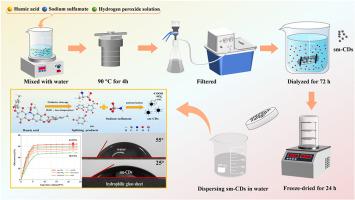A mild oxidation cleavage-and-polymerization strategy towards sulfonate-modified carbon dots for enhanced oil recovery
IF 4.6
0 ENERGY & FUELS
引用次数: 0
Abstract
As a new type of oil displacement agent, carbon dots (CDs) with ultrasmall size show great potential in developing unconventional reservoirs. However, the complex synthesis process, high energy consumption, and difficulty in surface modification restrict their practical applications. Herein, we propose a facile and mild oxidation cleavage-polymerization strategy for engineering sulfonate-modified carbon dots (sm-CDs) based on a low-temperature hydrothermal technology for enhanced oil recovery (EOR). This methodology employs humic acid as the carbonaceous precursor and sodium sulfamate as the sulfonation agent, utilizing hydrogen peroxide-mediated oxidative initiation under mild hydrothermal conditions (90 °C). The synthetic method achieves concurrent oxidative cleavage of humic acid macromolecules and subsequent polycondensation with sulfonation moieties, enabling one-step in situ functionalization of CDs with modified surface sulfonate groups. The sm-CDs demonstrate outstanding performance in dispersion stability under extreme reservoir conditions (high-temperature: 90 °C and high salinity: 5 × 104 mg/L NaCl), and the interfacial activity. Core flooding tests show that 0.2 wt% sm-CDs nanofluid significantly reduces the injection pressure by 62.15 % and increases the oil recovery from 48.14 % to 63.92 % compared with water flooding. Subsequent investigation indicates the tailored sm-CDs adsorb on core surface, which improves the heterogeneity of wettability and decreases the average oil-rock adhesion forces from 1.621 to 0.091 nN, thereby effectively enhancing the oil displacement. This study provides a valuable reference for the development and application of efficient CDs nanomaterials in the oilfield.

硫酸盐改性碳点的轻度氧化裂解聚合策略提高石油采收率
超小尺寸碳点驱油剂作为一种新型的驱油剂,在非常规油藏开发中显示出巨大的潜力。但合成工艺复杂、能耗高、表面改性难度大,制约了其实际应用。在此,我们提出了一种基于低温水热技术的工程磺酸改性碳点(sm-CDs)的简单而温和的氧化裂解聚合策略,以提高石油采收率(EOR)。该方法以腐植酸为碳质前体,磺胺酸钠为磺化剂,在温和水热条件下(90℃)利用过氧化氢介导的氧化引发反应。该合成方法实现了腐植酸大分子的同步氧化裂解和随后与磺化基团的缩聚,从而实现了具有改性表面磺酸基的CDs的一步原位功能化。sm-CDs在极端储层条件下(高温:90℃,高盐度:5 × 104 mg/L NaCl)的分散稳定性和界面活性方面表现出色。岩心驱油试验表明,与水驱相比,0.2 wt%的sm-CDs纳米流体可显著降低注入压力62.15%,将采收率从48.14%提高到63.92%。随后的研究表明,定制的sm-CDs吸附在岩心表面,改善了润湿性的非均质性,将平均油-岩附着力从1.621 nN降低到0.091 nN,从而有效地提高了驱油效果。该研究为高效CDs纳米材料在油田的开发和应用提供了有价值的参考。
本文章由计算机程序翻译,如有差异,请以英文原文为准。
求助全文
约1分钟内获得全文
求助全文

 求助内容:
求助内容: 应助结果提醒方式:
应助结果提醒方式:


